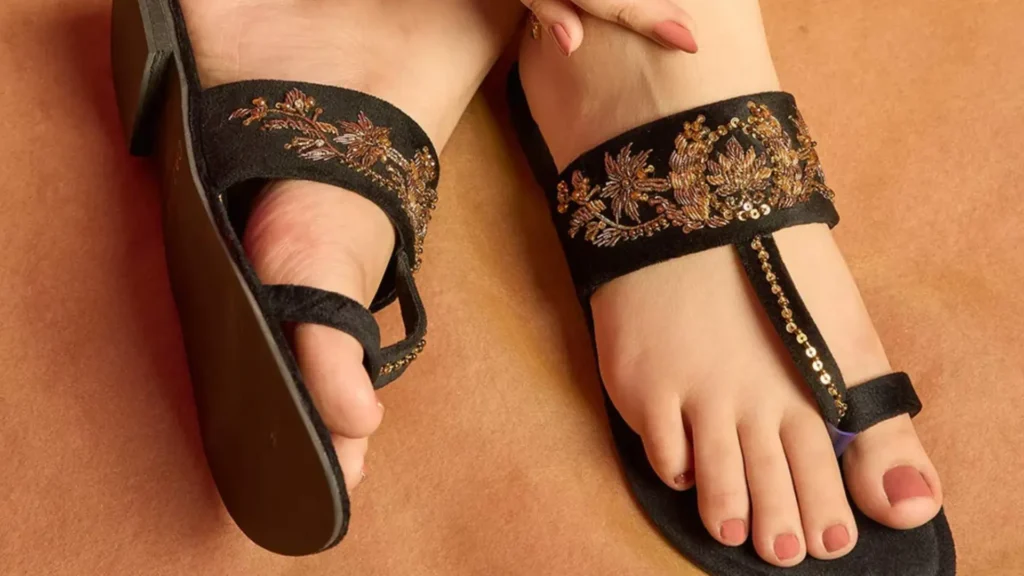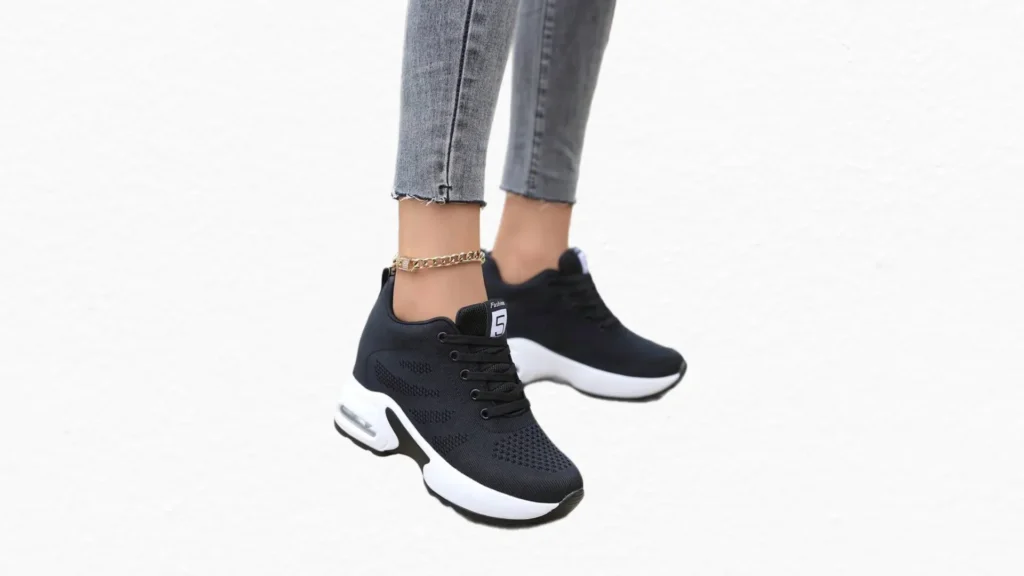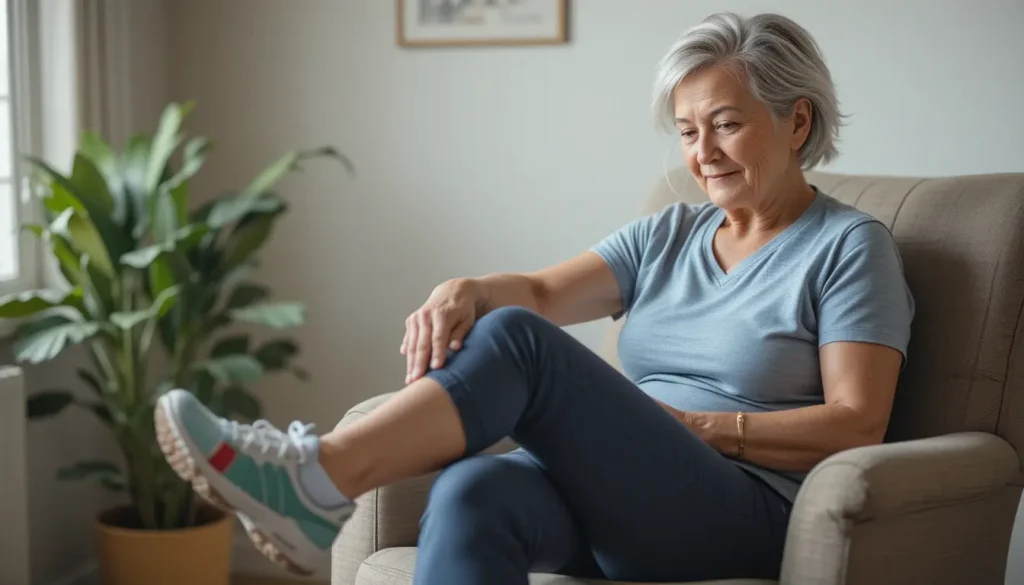Kolhapuri chappals, the iconic handcrafted leather footwear from Maharashtra, India, have long been celebrated for their durability, elegance, and cultural heritage. Once limited to local markets and regional use, these traditional sandals are now making their way onto the global fashion stage.
From artisan workshops in Kolhapur to fashion runways in Europe and online marketplaces worldwide, Kolhapuri chappals are experiencing a revival driven by rising interest in sustainable fashion and ethnic craftsmanship.
This global journey reflects not only the chappals’ timeless appeal but also the evolving strategies of artisans, designers, and exporters who are reimagining this heritage craft for international audiences.
The Story of Kolhapuri Chappals
More than 200,000 pairs of Kolhapuri chappals are made every year. Each one is a blend of history, craftsmanship, and comfort.
Kolhapuri chappals come from Kolhapur, a city in Maharashtra. They have been around for over 150 years. These sandals were once worn by kings and nobles. Today, they are loved by people across India and beyond.
The style was inspired by royal footwear. Over time, it became more accessible. But the quality and design stayed strong.
Each pair is handcrafted by skilled artisans. It takes several days to make one chappal. The process uses tools that have not changed in decades.
Leather comes from local sources. It is soft but tough. Artisans cut, stitch, and shape each part with care. This handmade touch gives them their unique feel.
Design That Stands Out
Kolhapuri chappals have open toes and no back straps. The upper part has patterns made with small leather pieces. These designs are stitched together like a puzzle.
Each region adds its own twist. Some styles have beads or coins. Others use bold colors or simple lines. No two pairs are exactly alike.
These chappals mold to your feet over time. They become more comfortable with each wear. The sole is thick enough to protect but flexible enough to move.
Because they are handmade, the fit feels personal. There is space for your foot to breathe. Walking in them feels natural.
Kolhapuri chappals are a symbol of culture. They connect people to tradition. Many weddings, festivals, and events see these chappals as a must-have.
They are also popular among eco-conscious buyers. Since they are made by hand, they leave a smaller footprint. Buying them supports local workers and heritage.
A Style That Travels Far
Today, you can find Kolhapuri chappals in fashion shows and city streets. They are worn with jeans, dresses, and office clothes. Their look blends old charm with modern flair.
Celebrities and designers have helped bring them into the spotlight. Yet, their roots remain in the quiet workshops of Kolhapur.
Many young artisans continue the craft passed down through families. Each new pair keeps the tradition alive. With growing demand, this legacy is gaining fresh life.
Efforts are being made to teach new skills while keeping old methods. Workshops and training centers help keep the art sustainable.
A Global Footprint from a Small Town
Kolhapuri chappals are being marketed internationally through fashion collaborations, e-commerce platforms, and cultural storytelling that highlights their craftsmanship, sustainability, and heritage.
Over the last decade, Kolhapuri chappals have reached more than 30 countries. What began as local footwear in Maharashtra is now seen on streets in London, New York, and Tokyo.
Designers and exporters are showing these handcrafted sandals to the world. They are not just selling shoes but sharing a legacy.
Each pair carries the mark of tradition and authenticity. This unique identity has become a strong selling point in international markets.
Digital Platforms Open New Doors
Top fashion houses in India have included Kolhapuri chappals in their collections. These designs have caught the attention of global buyers and influencers.
The open-toe style and handmade look blend well with modern outfits. Buyers abroad see them as stylish yet grounded in culture.
International fashion weeks now feature models wearing updated versions of Kolhapuri chappals. This exposure helps build curiosity and demand.
E-commerce has played a big role in taking Kolhapuri chappals overseas. Online marketplaces allow small makers to reach customers far away.
Brands use clear photos, detailed descriptions, and stories about the artisans. These details help buyers connect with what they are purchasing.
Social media also plays a key role. Instagram and Pinterest showcase how versatile and stylish the chappals can be.
Influencers wear them with dresses, skirts, or casual wear. This visual appeal draws new buyers who want both comfort and character.
Sustainability Sells
Buyers around the world care more about eco-friendly shoes. Kolhapuri chappals fit this trend because they are made by hand using natural leather.
No machines, no mass production. Just skilled hands shaping each piece with care. This slow-fashion approach appeals to conscious consumers.
Labels highlight the minimal carbon footprint and long-lasting design. These points make Kolhapuri chappals stand out among fast-fashion brands.
This focus on ethical making helps them compete with other global footwear brands.
Sellers are packaging Kolhapuri chappals as more than footwear. They are presented as symbols of Indian culture and artistry.
Boxes include notes about where they come from and who made them. Some even share the artisan’s name or village.
This personal touch builds trust and emotional value. Buyers feel they are supporting real people and traditions.
It also makes the product memorable and meaningful beyond its design.
Partnerships That Push Boundaries
Indian designers are teaming up with foreign labels to bring Kolhapuri styles to new audiences. These partnerships mix old techniques with fresh ideas.
Some lines use bold colors or add modern straps while keeping the classic base. These updates attract younger shoppers who still appreciate quality.
Trade fairs and pop-up stores in Europe and the U.S. help introduce the chappals directly. Buyers get to see and feel the work that goes into each pair.
These events often include live demos by artisans. Watching the process adds depth to the product.
Exports of Kolhapuri chappals have grown by over 40% in five years. This rise is supported by trade bodies and government programs.
Initiatives offer training in design, packaging, and export rules. Artisans learn how to meet international standards without losing their style.
Funding helps small makers invest in better tools and materials. This improves the final product and builds confidence in the brand.
Such support ensures that growth doesn’t come at the cost of quality.
A Global Journey from Kolhapur to the World
The top countries importing Kolhapuri chappals are the United States, the United Kingdom, Canada, Australia, and Germany.
Every year, thousands of pairs of Kolhapuri chappals leave India for faraway lands. These handcrafted sandals have found homes in cities across five continents.
What started as a local craft is now part of global fashion culture. People in distant countries are choosing these chappals for their style and story.
Each country has its own reason for loving Kolhapuri footwear. Yet, all share a respect for quality and tradition.
The U.S. is one of the largest importers of Kolhapuri chappals. Over the past few years, demand has risen steadily.
Yoga lovers, eco-conscious buyers, and fashion fans are drawn to the handmade look. They see them as both comfortable and meaningful.
Online stores and pop-up shops in New York and California help spread awareness. Indian-American communities also play a big role in keeping the trend alive.
In the UK, Kolhapuri chappals are popular among South Asians and fashion-savvy locals alike. London and Birmingham are key hubs for sales.
British buyers appreciate the craftsmanship and sustainability aspect. They are looking for products that tell a story.
Fashion shows and cultural events have helped raise visibility. This makes it easier for small brands to find loyal customers.
Canada ranks high in imports due to its large Indian diaspora. Many families keep ties with Indian traditions through clothing and footwear.
Kolhapuri chappals fit well into this lifestyle. They are worn at weddings, festivals, and casual gatherings.
Stores in Toronto, Vancouver, and Calgary stock them regularly. Online delivery ensures remote areas can enjoy these classic sandals.
Australia has seen a steady rise in Kolhapuri chappal imports. Buyers there value handmade goods and ethical production.
These sandals are worn by students, artists, and travelers who love unique styles. Their open design suits the warm climate down under.
Indian communities in Sydney and Melbourne support local sellers. This helps maintain a consistent flow of orders from India.
Germany stands out as a top European buyer. German consumers care about sustainability and fair trade practices.
Kolhapuri chappals match these values because they are made by hand without machines. This attracts buyers who want honest, durable products.
Design schools and artisan fairs in Berlin and Frankfurt have featured them. This builds interest beyond just the Indian community.
Countries such as France, Italy, Japan, and the Netherlands are also showing growing interest. These markets are smaller but rising fast.
Fashion influencers in Tokyo and Milan have been spotted wearing updated Kolhapuri designs. This helps draw attention from young buyers.
Exporters are tailoring designs to suit local tastes while keeping the core look intact. This balance helps win new fans without losing authenticity.
How These Chappals Reach Faraway Shores
Exports are mostly handled by small businesses and cooperatives in Kolhapur. They work with international partners to manage shipping and marketing.
E-commerce plays a major role. Platforms allow artisans to sell directly to global buyers.
Social media also helps. Photos and videos show how each pair is made, giving buyers a closer look at the process.
Each country that imports Kolhapuri chappals adds its own chapter to the story. These sandals are more than shoes—they carry pride, history, and identity.
Artisans take care in making every pair perfect. Knowing their work travels so far gives them a sense of purpose.
Buyers abroad feel connected to India’s rich heritage. Each step in these chappals becomes a celebration of culture.
As exports grow, so do opportunities for workers in Kolhapur. More jobs mean better lives for families in the region.
Young people are staying in the craft instead of moving to cities for other work. This keeps the tradition alive for future generations.
Training centers teach new skills while preserving old methods. This ensures quality stays high and growth remains sustainable.
A Struggling Road from Kolhapur to the World
Artisans face challenges such as language barriers, differing size standards, high shipping costs, competition from mass-produced footwear, and limited access to global marketing tools when taking Kolhapuri chappals to the global market.
Over 200 artisan families in Kolhapur rely on making chappals for their livelihood. Yet, selling beyond India is not as simple as it seems.
Each pair takes days of careful work. But reaching international buyers involves more than just good craftsmanship.
The journey from workshop to global shelf is filled with hurdles. These can slow down growth and test the spirit of artisans.
Language and Communication Gaps
Most artisans in Kolhapur speak Marathi or Hindi. English, which is widely used in global trade, is not common among them.
This makes it hard to write product descriptions or reply to customer queries. Miscommunication can lead to lost sales or unhappy buyers.
Translating content accurately without losing meaning is another layer of difficulty. Some messages get mixed up in translation.
Without clear communication, building trust with foreign customers becomes harder.
Different Size Standards Around the World
India uses its own sizing system for footwear. This does not always match the European or American systems.
Artisans struggle to convert sizes correctly. Buyers abroad may order a size that doesn’t fit.
Returning shoes from faraway countries adds cost and effort. It also delays future sales.
Getting size charts right is key, but not always easy for small makers.
Shipping handmade goods overseas can be expensive. For small businesses, this cuts into earnings.
Packaging must be strong enough to protect the product during long journeys. That adds to the cost.
Some orders are too small to justify the expense. Artisans end up missing out on potential buyers.
Handling customs rules and paperwork also takes time and money. Many do not have help with this.
Competition from Mass-Produced Imitations
Big factories copy the look of Kolhapuri chappals using machines. These fake versions are cheaper and faster to make.
Buyers who don’t know the difference may choose these instead. They miss out on real craftsmanship.
These imitations flood online stores and big retailers. They hurt the reputation of genuine handcrafted pairs.
Artisans find it hard to compete with low prices they cannot match.
Most artisans focus on making chappals, not promoting them. Digital marketing, branding, and social media are new concepts.
They may not know how to reach global audiences or use online tools effectively. Learning curves are steep.
Hiring experts is not always possible due to limited funds. This limits visibility in crowded markets.
Without proper marketing, even the best products can go unnoticed.
Maintaining Quality While Meeting Demand
As demand grows, keeping up with quality becomes harder. Rushing production leads to mistakes.
Some artisans take on more orders than they can handle. This affects the finish and durability of each pair.
Maintaining the traditional method while scaling is a delicate balance. It requires planning and support.
Too much pressure can lead to burnout or lower motivation.
Adapting to New Trends Without Losing Identity
Global buyers sometimes ask for changes in design or material. Some requests clash with traditional styles.
Artisans must decide what to adjust and what to keep. Straying too far can lose authenticity.
Sticking strictly to old ways might turn away modern buyers. Finding middle ground is tricky.
Each decision shapes how Kolhapuri chappals are seen around the world.
Small makers rarely get loans or grants to expand. Banks may not see handmade footwear as a safe investment.
Export training and business development programs are not always available. When they are, getting access is tough.
Many rely only on local networks and word-of-mouth. This slows down growth.
Support from government or private groups could change the game, but it’s still limited.
The Emotional Toll of Uncertainty
Every challenge adds stress to the lives of artisans. Their income depends on how well the chappals sell.
One bad batch of orders or a missed shipment can cause worry. Supporting families becomes harder during slow times.
Despite all this, many continue out of love for the craft and hope for better days. Their resilience keeps the tradition alive.
Their stories are full of struggle, patience, and quiet strength.
Despite the many obstacles, artisans in Kolhapur keep crafting with care. Each chappal tells a story of skill, pride, and perseverance.
With better support and awareness, they can overcome these hurdles. Their work deserves a fair chance in the world.
As buyers learn more about real Kolhapuri chappals, the future looks brighter. One step at a time, tradition and global trade can walk together.
A Fresh Look for a Global Stage
The design of Kolhapuri chappals has evolved to appeal to global consumers through updated silhouettes, modern color choices, the use of lightweight materials, and subtle fusion elements that blend traditional craftsmanship with contemporary style.
Once worn mainly in western India, Kolhapuri chappals are now spotted on fashion streets from Paris to New York. This shift didn’t happen by chance.
Designers and artisans have made small but meaningful changes to the classic look. These tweaks help the chappals fit into different lifestyles and climates.
What was once seen as purely ethnic footwear is now part of a broader fashion story. The evolution is slow but sure.
Traditional Kolhapuri chappals are broad and sturdy, built for comfort over long wear. But global buyers prefer sleeker shapes.
New designs feature narrower soles and lighter uppers. The structure stays true to the original but feels more refined.
These slimmer versions pair well with jeans, skirts, and casual dresses. They no longer feel out of place outside Indian outfits.
This subtle change helped open doors to new markets without losing the soul of the craft.
Earlier, Kolhapuri chappals came mostly in black, brown, or tan leather. Bright colors were rare and mostly used for festive events.
Today, shades like navy blue, olive green, and mustard yellow are common. Some pairs come in pastels or two-tone finishes.
These new color options match better with international wardrobes. Buyers can mix and match them easily.
A wider palette means more personal expression and wider appeal.
Older versions used thick, heavy leather for durability. While strong, this made them less ideal for all-day wear in cooler climates.
Modern versions sometimes use thinner but still durable leather. Some blends mix natural hide with softer synthetic layers.
The result is a chappal that feels lighter on the feet but lasts just as long. Comfort has become a key selling point abroad.
This shift shows how tradition can adapt without giving up its roots.
Some designers have added ankle straps, buckles, or heel lifts to the basic design. These small additions give the chappals a fresh edge.
Others have blended Kolhapuri stitching styles with Western sandal shapes. These hybrids feel familiar yet unique.
Such fusions help the chappals blend into global fashion scenes. They feel at home in both streetwear and semi-formal looks.
These updates respect the craft while making it relevant for today’s world.
Indian foot shapes differ from those in Europe or the Americas. Standard sizes did not always suit foreign buyers.
To fix this, some makers started offering multiple size charts. Others adjusted toe box width and arch support.
Better fit led to better reviews and repeat orders. It also reduced returns and confusion.
This attention to detail made Kolhapuri chappals more trustworthy in global eyes.
While traditional chappals are richly decorated with beads and metal work, minimalist versions skip these extras. Clean lines and simple patterns took center stage.
These understated looks suit office settings, travel days, or city walks. They don’t feel too flashy or ceremonial.
Minimalism also makes the chappals easier to carry across borders. They fit into compact luggage and daily routines.
This practical side boosted their popularity among working professionals abroad.
Each new design now comes with a tag that tells the maker’s story. Some include the artisan’s name, village, or method.
This builds trust and emotional connection. Buyers feel they are supporting real people.
It also helps Kolhapuri chappals stand apart in a market full of fast fashion. Each pair becomes more than a product.
This human touch is proving powerful in attracting conscious shoppers.
The global rise of Kolhapuri chappals is more than a fashion trend—it’s a testament to the power of cultural craftsmanship in a connected world. As Kolhapuri chappals step confidently into global markets, they carry with them a legacy of heritage, sustainability, and artisan pride—making them not just footwear, but a global cultural statement.




